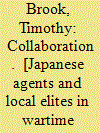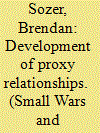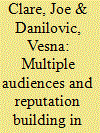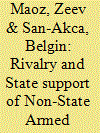| Srl | Item |
| 1 |
ID:
060537


|
|
|
|
|
| Publication |
Cambridge, Harvard University Press, 2005.
|
| Description |
xi, 288p.Hbk
|
| Standard Number |
0674015630
|
|
|
|
|
|
|
|
|
|
|
|
Copies: C:1/I:0,R:0,Q:0
Circulation
| Accession# | Call# | Current Location | Status | Policy | Location |
| 049504 | 940.531630951/BRO 049504 | Main | On Shelf | General | |
|
|
|
|
| 2 |
ID:
146228


|
|
|
|
|
| Summary/Abstract |
Proxy warfare is a consistent element in international warfare. However, it is unclear why proxy relationships form in cases where states have multiple options of groups to support. Existing research identifies the presence of transnational constituencies, shared interstate rivalries, and moderate relative strength of militant groups as highly influential on the development of a proxy relationship. This study examines the presence of these variables within the context of the Lebanese Civil War. The results of this demonstrate that each state places greater importance on some variables and ignores others when choosing a proxy. Additionally, this study further demonstrates the presence of new variables that are key to the development of proxy relationships.
|
|
|
|
|
|
|
|
|
|
|
|
|
|
|
|
| 3 |
ID:
101682


|
|
|
|
|
| Publication |
2010.
|
| Summary/Abstract |
Reputational theory of conflict behavior dates back to Schelling's seminal work on bargaining and continues to find both its advocates and critics to date. The authors do not take sides in this debate about the relevance of reputation for bargaining behavior but rather take a modified approach to reputations for resolve and probe some aspects that were largely underexplored in past research. The authors develop the argument that, if facing multiple strategic rivals and having failed in past disputes, a state has an incentive to invest in its reputation for resolute behavior by initiating and escalating conflicts. Their focus is then on both general and immediate deterrence, and while it was standard to tie reputation to a deterrer's past, the authors direct the attention to the challenger's reputation as a potential motivator for its conflictual behavior. This new focus is validated, and the related expectations supported, in the findings from their empirical analysis of strategic rivalries from 1816 to 1999.
|
|
|
|
|
|
|
|
|
|
|
|
|
|
|
|
| 4 |
ID:
118173


|
|
|
|
|
| Publication |
2012.
|
| Summary/Abstract |
This study examines the conditions under which states engaged in strategic rivalries choose to support Non-state Armed Groups (NAGs) that target their rivals. NAGs include ethnic or religious insurgents, guerilla organizations, and terrorists. We develop a rational choice model of state support for NAGs. We focus on state support of NAGs as cooperation between states and NAGs emerging out of a mutual and purposive decision-making process. The model suggests that decisions of states to support NAGs targeting a rival are affected by dissatisfaction with the status quo and the expected risk of retaliation. Rivalries create opportunities for NAGs that operate against one of the rivals, allowing them to acquire resources to sustain their operations. The presence of rivalry increases the likelihood of state-NAG cooperation. In turn, state-NAG cooperation increases the likelihood of rivalry escalation. We test the propositions of the model using an original data set that includes observations for 175 NAGs and 83 state supporters in the post-WWII period. We find consistent support for our propositions. We discuss the implications of these results for the theory and practice of international relations.
|
|
|
|
|
|
|
|
|
|
|
|
|
|
|
|
| 5 |
ID:
084466


|
|
|
|
|
| Publication |
2008.
|
| Summary/Abstract |
Scientific, institutional and personal rivalries between three key centres of geographical research and scholarship (the Academy of Sciences Institute of Geography and the Faculties of Geography at Moscow and Leningrad State Universities) are surveyed for the period from 1945 to the early 1950s. It is argued that the debates and rivalries between members of the three institutions appear to have been motivated by a variety of scientific, ideological, institutional and personal factors, but that genuine scientific disagreements were at least as important as political and ideological factors in influencing the course of the debates and in determining their final outcome.
|
|
|
|
|
|
|
|
|
|
|
|
|
|
|
|
| 6 |
ID:
145694


|
|
|
|
|
| Summary/Abstract |
Why do states form non-aggression pacts? Non-aggression pacts are different from typical alliances because the latter tend to be focused on relationships between members of the alliance and other states, such as by deterring external threats or mediating the resolution of conflicts between an alliance member and a third-party challenger. We offer two contributions that build on existing work. First, we provide a theory that explains why leaders use non-aggression pacts as information mechanisms. Leaders of states that have recently emerged from a rivalry seek to overcome an important information asymmetry: they know the probability of future conflict among the former rivals has decreased, but other actors may fear a resumption of hostilities. Such leaders use non-aggression pacts to signal that the rivalry has truly ended and that future relations are likely to remain peaceful. Second, our analysis recognizes the often multilateral nature of the non-aggression pact formation process. We use the ‘k’-adic statistical procedure to model non-aggression pact formation as a multilateral process. To operationalize recent rivalry cessation within a group, we use a network analytic density measure. Consistent with our theory, we find that groups of states with greater densities of recently ended rivalries are significantly more likely to form non-aggression pacts. These results hold across a series of model specifications.
|
|
|
|
|
|
|
|
|
|
|
|
|
|
|
|
| 7 |
ID:
126237


|
|
|